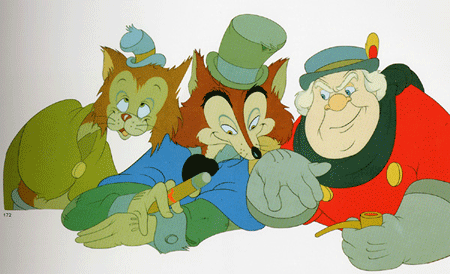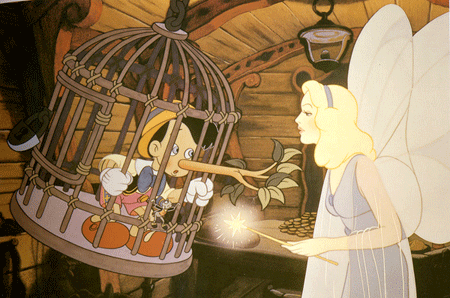Disney's version of Pinocchio, released into the cinema in 1940, is the storyline that most children and adults are familiar with. While Disney's first attempt at a film based upon Collodi's text from 1880 stuck closely to the original plot, the producers eventually decided to make a happier, lighthearted film that tends to portray Pinocchio's journey in a more positive light. Pinocchio finds himself in less severe situations with far fewer negative ramifications. The Disney film has Pinocchio travel on a journey to find honesty and selflessness, similarly to how Collodi depicts the wooden puppet. Many liberties are taken, however, such as the addition of Jiminy Cricket as a leading character, as well as the elimination of multiple "darker" episodes within the storyline.
Disney's artwork reflects upon the more child-friendly storyline. Pinocchio as a puppet (to the right) appears almost identical to Pinocchio as a real boy (upper left). The realism with which the puppet form of Pinocchio is drawn creates a less startling image than other depictions, which tend to focus on the inanimate, wooden side of the puppet. Gepetto's home is shown as warm, friendly, and fun, Collodi's text emphasizes the fact that he was a pauper, barely able to purchase food or clothing. Collodi also makes a point of making his villains, the fox and the cat, rather sinister characters. Although Disney tries to create "bad" or mean characters, their depiction (below) is not incredible scary by any means, but rather more child-oriented.
Disney presents an idealized story where Pinocchio can always seem to find his way out of danger without significant ramifications. The Blue Fairy often comes to his aid when he is in trouble to rescue him and teach him a moral lesson. The Blue Fairy, while also a pivotal character in Collodi's text, strongly resembles a pixie, equipted with wings and dressed in a flowing gown. Her appearence never changes, however, unlike in Collodi's original, where she takes on multiple forms, ranging from a young girl with blue hair, to a middle-aged woman. While the Blue Fairy is mainly responsible for the magic behind Pinocchio's transformation in each version, her role is much more prominent throughout Collodi's text.


